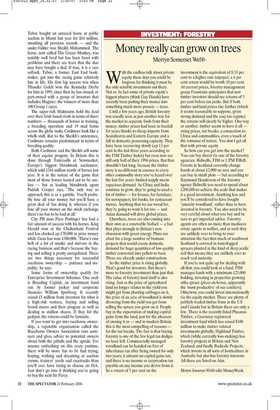Money really can grow on trees
Merryn Somerset Webb With the endless talk about private equity these days you could be forgiven for thinking it must be the only sensible investment out there. Not so. In fact some of private equity's biggest players (think Guy Hands) have recently been putting their money into something much more prosaic — trees.
Until a few years ago, British forestry was usually seen as just another way for the market to separate fools from their money: timber prices had been in freefall for years thanks to cheap imports from Scandinavia and Eastern Europe and a fall in domestic processing capacity. They have been recovering slowly (up 13 per cent in the last three years according to the FIM Timber Index) but even now are still only half of their 1996 prices. But that shouldn't last long, because the timber story is no different in essence to every other commodity story you've heard over the last five years: limited supply meets rapacious demand. As China and India continue to grow, they're going to need a lot of timber — for houses, for furniture, for newspapers, for books, for restaurant menus. Anything that we use wood for, they're going to want it for too — and Asian demand will drive global prices.
Elsewhere, trees are also coming into their own as a renewable biofuel — a fact that plays strongly to Britain's new obsession with green energy. Plans are afoot for a large number of biomass projects that would create domestic demand for huge quantities of low-quality timber converted into pellets to burn. Three are already under construction.
So the timber price is rising globally. That's good for investors. But there's more to forestry investment than just that. The value of forestry land itself is also rising. Just as the price of agricultural land no longer relates to the yield you might get from planting cabbages on it, the price of an acre of woodland is slowly divorcing from the yield you get from selling the spruce you grow on it. People buy in the expectation of making capital gains from the land, just for the pleasure of owning it or — and in modern Britain this is the most compelling of reasons — for the tax breaks. The fact is that buying forestry is one of the few legal tax dodges we have left. Commercially managed woodland can be handed on free of inheritance tax after being owned for only two years; it attracts no capital gains tax; and there is no income or corporation tax payable on any income you derive from it. So a return of 5 per cent on the investment is the equivalent of 8.33 per cent to a higher-rate taxpayer; a 6 per cent return would be worth 10 per cent. At current prices, forestry management group Fountains anticipates that new timber investors should see returns of 5 per cent before tax perks. But if both timber and land prices rise further (which it seems reasonable to suppose, given strong demand and the easy tax regime) the returns will clearly be higher. One way or another, timber seems to have it all — rising prices, tax breaks, a connection to China and commodities, even a touch of the romance of nature. You don't get all that with private equity.
So how can you get into the market? You can buy direct via one of the forestry agencies: Bidwells, FIM or UPM Tilhill. Forests in Scotland currently change hands at about £2,000 an acre and you can buy in small plots — but according to Raymond Henderson of the forestry agency Bidwells you need to spend about £200,000 to achieve the scale that makes it a good investment. Anything less and you'll be considered to have bought 'amenity woodland', rather than to have invested in forestry. You also need to be very careful about what you buy and be sure to get impartial advice. Forestry agents are often no more than mediocre estate agents in wellies, and as such they are unlikely ever to bring to your attention the fact that much of southwest Scotland is covered in waterlogged spruces planted in the kind of deep acidic soil that means they are unlikely ever to reach real maturity.
If you're not quite up for dealing with all that, you could look at a fund. FIM manages funds with a minimum £25,000 holding, investing in properties growing sitka spruce (picea sitchensis, apparently the 'most productive' of our conifers). Otherwise you could invest internationally via the equity market. There are plenty of publicly traded timber firms in the US and Canada but in Britain there are only a few. There is the recently listed Phaunos Timber, a Guernsey-registered investment fund which has raised $100 million to make timber-related investments globally; Highland Timber, which (while currently loss-making) has forestry projects in Britain and New Zealand; and finally Radicale Projects, which invests in all sorts of horticulture in Australia but also has forestry interests. All three are listed on Aim.
Menyn Somerset Webb edits MoneyWeek.






















































 Previous page
Previous page